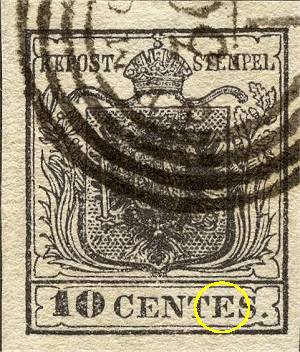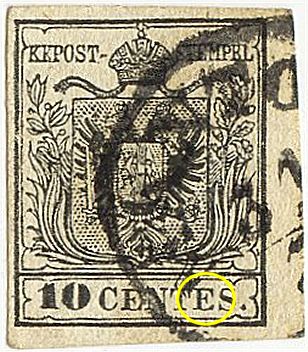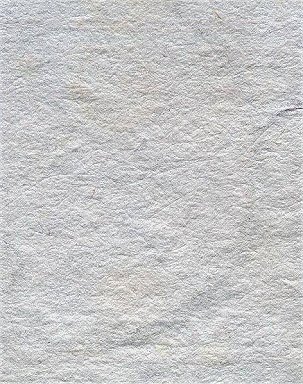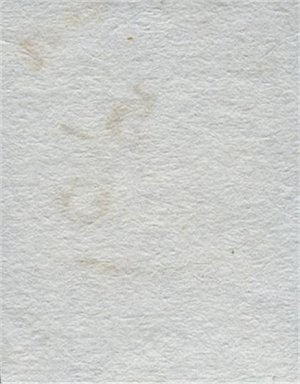The
Lombardy-Venetia first issue has been printed by using various paper material,
very different both as type of paper as well as quality: thick, thin, wrinkled,
porous, "waste", ribbed, laid, "cardboard",
coarse, smooth, etc. etc..
The paper first differentiating element is the HAND or MACHINE made type of
paper.
In the list below I outline the different paper types used to print the various
values (for the identification of the stamps types please see the specific
descriptions of the pieces).
|
Stamp
|
Type
|
Hand-made
|
Machine-made
|
|
5
centesimi
|
-
|
Yes
|
No
|
|
10
centesimi
|
-
|
Yes
|
Yes
(from July 1857) (*)
|
|
15
centesimi
|
I
|
Yes
|
No
|
|
15
centesimi
|
II
|
Yes
|
No
|
|
15
centesimi
|
III
|
Yes
|
Yes
(from January 1854)
|
|
30
centesimi
|
I
|
Yes
|
No
|
|
30
centesimi
|
II
|
Yes
|
Yes
(from May 1855)
|
|
45
centesimi
|
I
|
Yes
|
No
|
|
45
centesimi
|
II
|
Yes
|
Yes
(from end August 1856)
|
(*) the second "E" of"CENTES" is always close at bottom while it is open in hand-made paper
Identify
the paper type is not always easy specially if the stamp is still on the envelope.
Several elements can help in this identification. First of all we need to
identify the stamp type: it's obvious that a 15 centes of type II cannot leave
any doubt being printed only on handmade paper. Another tip can be given by
the year of usage if it is identifiable: machine made paper appears much after
the hand made paper; in addition late usage are almost always on machine paper.
No problems for the 5 centes (only on handmade paper) and for the 10 centes,
this one identifiable very easily because, as said before, the second "E"
of CENTES is always closed at bottom in machine made paper while is open in
hand made and for the printing very often much heavier and more "alive"
in the hand made in comparison to the machine made paper (Fig. 1 and 1a).
 |
 |
|
Fig.
1: hand-made paper
|
Fig.
1a: machine-made paper
|
Other elements help even more in limiting the possible
mistakes: for instance the type of engraving of the coat of arms ("native"
or "modified") and the spacing between the stamps ("narrow"
or "wide"). Each these details are object of other "Going
deep".
Most doubts, at the end, are coming from the 15 centes type III and for the
type II 30 and 45 centes.
A good magnifying lens and some comparison samples can really be very helpful.
Here is how the back of the two types should look like: the first on hand
made paper, the second on machine made paper (Fig. 2).
 |
 |
Hand
made paper appears clearly more porous and irregular, with details more in
relief, streaks and small wrinkles; the machine made paper is on the contrary
more homogeneous both as thickness (generally thicker) as well as on the surface.
To be truthful, it's possible to find stamps with hand made paper very regular
and therefore the identification becomes more difficult, but almost never
very complex. Also the observation of the stamp can give some help: the pieces
printed on hand made paper do have generally a printing less precise, more
often found with small ink irregularities, while in machine made paper the
printing is more regular and precise. They also are sometimes more vivid in
colors. In hand made paper is easier to find some plate faults, marks of typographic
spacing and printing "randdrucke" (see "Going deeper"):
all these elements can be found less easily in pieces on machine made paper.
Another characteristic of the hand made paper is the presence of the watermark
but only for few elements of the sheet: this argument is better explained
in another "Going deep...".
In summary we can say that the identification of the paper type is made is several ways: through the direct examination of the paper, with a good lens and samples to compare with, and finally from indirect examination of the characteristics elements of the stamp, when they are visible (plate, date of use, type of coat of arms, engraving type, printing quality, shade, color details, spacing, watermark, etc. etc.).